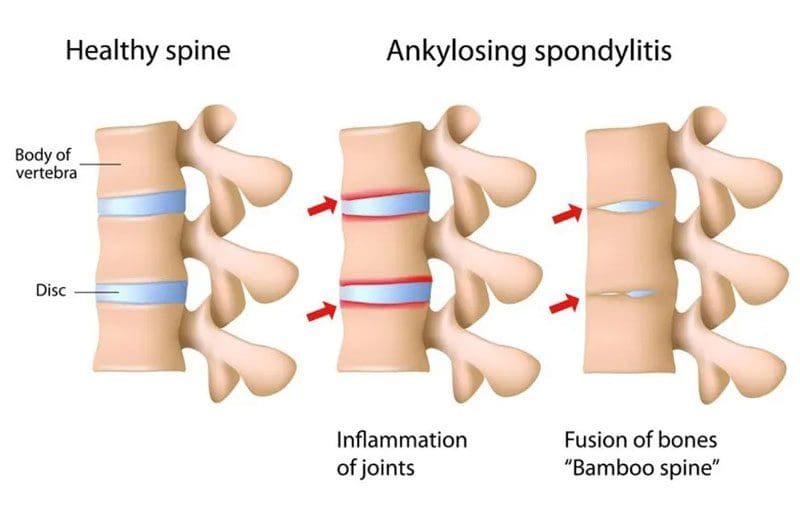
Spondylitis Anti-Inflammation Diet
Spondylitis Anti-Inflammation Diet: Individuals who have a chronic back pain condition can be recommended to have two or more vertebrae fused to correct the problem/s and alleviate the pain. However, a form of inflammatory spinal arthritis can cause the vertebrae to fuse by themselves, known as ankylosing spondylitis. One recommended way to bring pain relief is by eating an anti-inflammatory diet. Studies have shown that a low-inflammatory diet can help improve spondylitis symptoms.

Spondylitis Anti-Inflammation Diet
Ankylosing spondylitis is a progressive inflammatory disease that primarily affects the spine; however, individual symptoms vary. Symptoms include stiffness and pain in the neck, hips, low back, and fatigue. There is no definite pattern meaning:
- Symptoms can improve.
- Symptoms can worsen or flare up.
- Symptoms can stop for a period of time.
Women are affected more often than men with no known cause. There is no cure for ankylosing spondylitis, but treatments and self-care can slow down the disease’s progression and help manage symptoms.
Diet and Inflammation
Diet is not the root cause of inflammatory disease, but eating inflammation-causing foods can worsen symptoms. Reducing inflammation can help alleviate pain.
- Eliminating foods that cause or increase inflammation is recommended to help the body become stronger and manage symptoms.
- Another way is to incorporate spondylitis anti-inflammation foods.
- Functional medicine practitioners can help guide individuals on maximizing healthy nutrition and using it to reduce pain and symptoms.
- If an individual has a genetic predisposition, their diet can be crucial to calm down the symptoms and help turn the autoimmune disease around.
A spondylitis anti-inflammation diet should be rich in vegetables, fruit, whole grains, and omega-3 fatty acids. Evidence shows that a diet low in starches can lead to less ankylosing spondylitis activity. Low-starch can also help limit the presence of Klebsiella pneumoniae, a bacteria that feeds on starch and is a known trigger for the onset and development of ankylosing spondylitis.
Foods To Eat
Leafy greens
- These include spinach, kale, Swiss chard, and collard greens containing magnesium and polyphenols that reduce inflammation.
- These can be raw or cooked with garlic and olive oil added to maximize benefits.
Cruciferous vegetables
- These contain sulforaphane, an antioxidant that includes broccoli cauliflower and can be eaten raw or cooked, roasted with olive oil, sauteed, and stir-fried.
Allium Vegetables
- These contain sulfuric compounds and quercetin, a flavonoid that helps reduce inflammation.
- These include red and yellow onions, leeks, garlic, and shallots.
- They can be eaten raw or cooked in salads, stir-frys, and sandwiches.
Berries
- These contain anthocyanin, an antioxidant flavonoid, and other antioxidants and polyphenols that help with inflammation.
- These include strawberries, raspberries, blueberries, blackberries and can be eaten raw, in smoothies, in salads, with oatmeal, or mixed in unsweetened yogurt.
Fruits
- Certain fruits contain quercetin and polyphenols to help with inflammation.
- These include apples, cherries, oranges.
Healthy oils
- Contain oleocanthal which acts similar to nonsteroidal anti-inflammatory medications and contains various antioxidants.
- These include olive oil for low heat cooking and avocado oil for high heat cooking to replace butter and margarine.
- It can be served in dressings and drizzled on foods.
Nuts and seeds
- These contain alpha-linolenic acid, which is a type of omega-3 fatty acid.
- Examples include walnuts, almonds, peanuts, pistachios, chia seeds, and ground flaxseeds.
- These can be served as snacks, salads, mixed in side dishes, topping, or added to unsweetened yogurt or oatmeal.
Fatty fish
- Omega-3 fatty acids help reduce inflammation.
- Examples include salmon, cod, rainbow trout, mackerel, and sardines.
- These can be baked, sauteed, grilled, mixed into salads, and stir fry.
Avoid These Foods
When making lifestyle adjustments for a spondylitis anti-inflammation diet, focus on reducing or removing processed foods and saturated fats. These include:
- Sugars from all sources like soda, sugary drinks, shakes, candy, and desserts.
- Trans fats, like those in fried foods like chips and fries.
- Starches, such as found in potatoes.
- Refined carbohydrates, processed grains that include white bread, and pastries.
- Red meat.
- Gluten.
- Dairy.
- Eggs.
Individuals may not be symptomatic with certain foods, but that doesn’t mean the foods should be consumed. Gluten, dairy, and eggs can cause potential problems as they compromise the gut and the immune system. These can set back the individual’s healing or remission.
Body Composition
What Happens To The Body When Eating Fruit
Fruit is made up of simple sugar called fructose, providing the body with a carbohydrate energy source. The natural sugar the body gets from a piece of fruit is not the same as processed fructose added to processed products like fructose corn syrup. Processed products are typically filled with empty calories and very little nutrition. When the body has fruit, the liver processes fructose before getting absorbed through the small intestine. Research shows that exposing the gut to more fiber-rich foods like fruit helps the gut achieve an anti-obese condition by increasing the good bacteria and reducing the obese bacteria. Essential nutrients from fruit include:
- Folate
- Vitamin C
- Vitamin B1
The USDA recommends making half of each meal/plate be fruit and vegetables.
References
Harvard Health Publishing. (November 16, 2021) “Foods that Fight Inflammation.” www.health.harvard.edu/staying-healthy/foods-that-fight-inflammation
Macfarlane, Tatiana V et al. “Relationship between diet and ankylosing spondylitis: A systematic review.” European journal of rheumatology vol. 5,1 (2018): 45-52. doi:10.5152/eurjrheum.2017.16103
Nielsen, Forrest H. “Magnesium deficiency and increased inflammation: current perspectives.” Journal of inflammation research vol. 11 25-34. January 18 2018, doi:10.2147/JIR.S136742
Rashid T, Wilson C, Ebringer A. The Link between Ankylosing Spondylitis, Crohn’s Disease, Klebsiella, and Starch Consumption. Clin Dev Immunol. 2013;2013:872632. doi: 10.1155/2013/872632.
Sharma, Satya P et al. “Paradoxical Effects of Fruit on Obesity.” Nutrients vol. 8,10 633. 14 Oct. 2016, doi:10.3390/nu8100633
van Buul, Vincent J et al. “Misconceptions about fructose-containing sugars and their role in the obesity epidemic.” Nutrition research reviews vol. 27,1 (2014): 119-30. doi:10.1017/S0954422414000067





